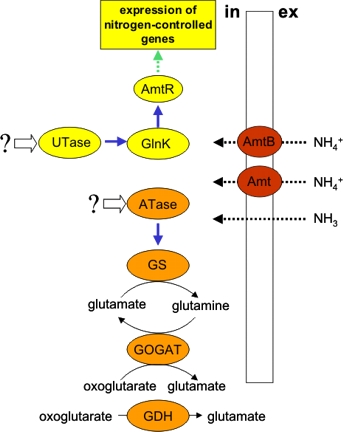GLOBAL REGULATION, GENOMICS AND PROTEOMICS
PD Dr. A. Burkovski, Dr. M. Silberbach, A. Wirtz, A. Wittmann, A. Lüdke, T. Müller,
J. Strösser, B. Walter, E. Hänssler, Daniel Ansorge
The picture on this page is taken from recent a
presentation. Please feel free to contact
us for further information.
| SCIENTIFIC BACKGROUND
Global regulatory networks allow bacteria to survive conditions of stress and starvation. They are indispensible for the adaptation of the cellular metabolism to a changing environment. Among these regulatory networks, the system responsible for controlling uptake of nitrogen sources and their assimilation is of major significance. |
AIMS
|
 Uptake of nitrogen sources (right hand side), ammonium assimilation pathways and connected regulatory networks in Corynebacterium glutamicum (signal transduction cascade). Blue arrows indicate regulatory protein-protein-interactions, broken green arrows regulation on the level of transcription, and black arrows solute transport.The question marks indicate until now unknown signal inputs. |
METHODS AND STRATEGY By a combination of biochemical and molecular biological approaches we were able to identify the key components for the uptake of nitrogen sources and the assimilation of ammonium in Corynebacterium glutamicum, as well as the central proteins of the signal transduction cascade and the master regulator of genes expressed in response to nitrogen shortage. The specific methods used, like RNA hybridization and gel shift experiments, RT-PCR, transport measurements and protein-protein interaction studies are combined with two global approa-ches, namely 2-D gel electrophoresis and transcription profiling via DNA arrays. The protocol for 2-D PAGE of C. glutamicum proteins was established in our group and is currently used to investigate the global response of C. glutamicum to nitrogen limitation and the role of posttranslational modifications for regulation (phospho-proteome). The work on the proteome level is flanked by a new project using DNA arrays to study the response of C. glutamicum to nitrogen shortage also on the level of transcription. Recently, a project was started to investigate nitrogen metabolism and regulation in the closely related Corynebacterium diphtheriae. |
| FUNDING | |
|
|
|
| COOPERATION | |
|
|
|
| SELECTED PAPERS |
|